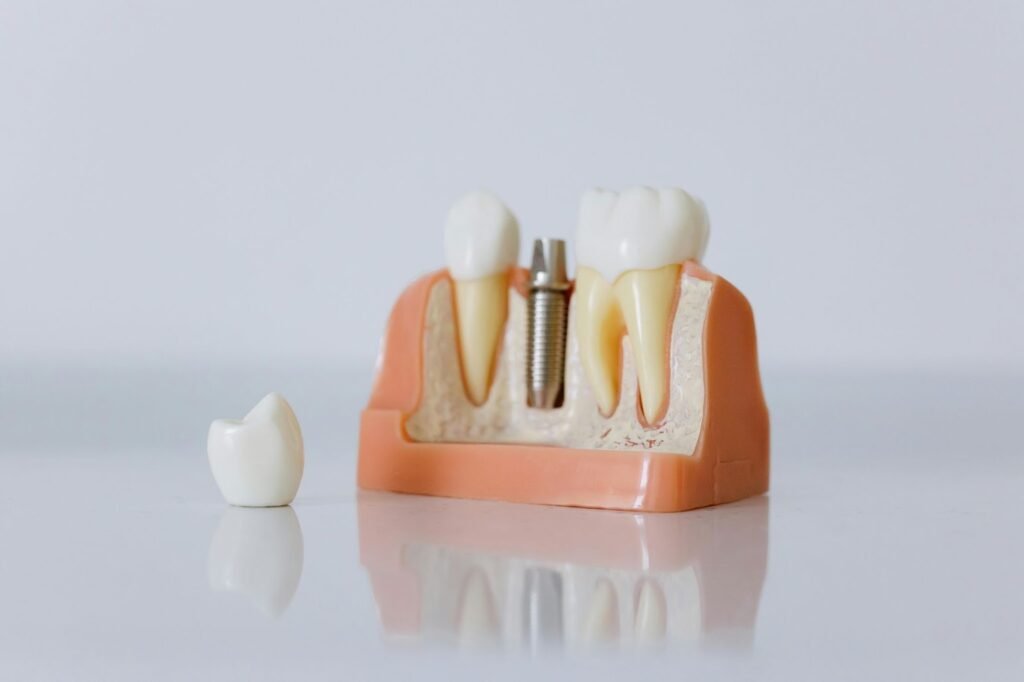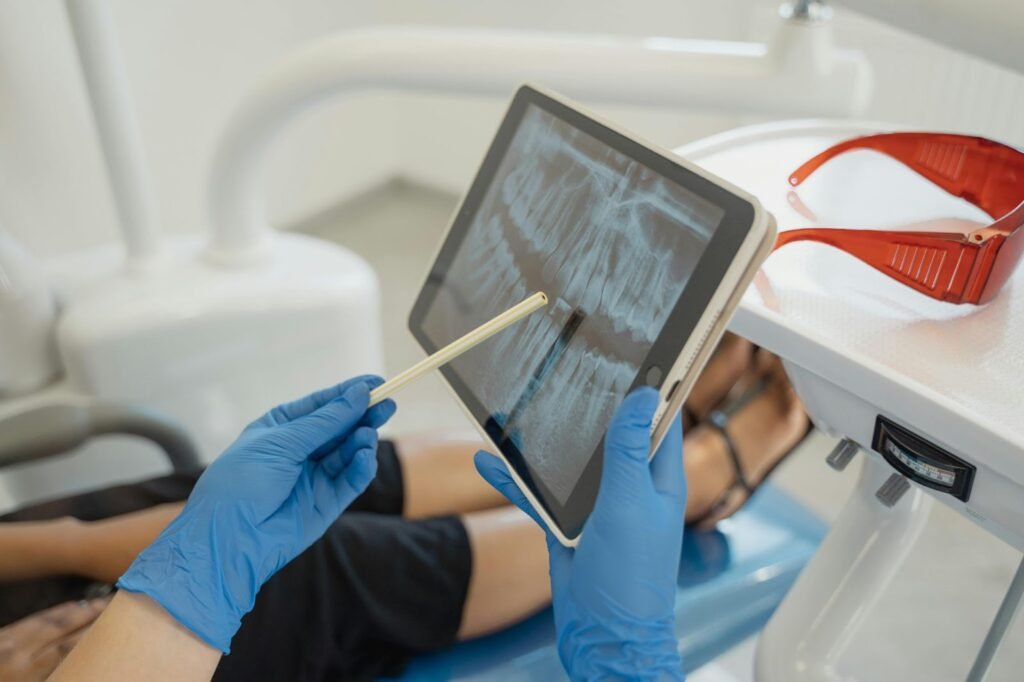Implants are essential in dentistry because they permanently replace missing teeth. Traditional implants, usually made from titanium, work like real teeth, making people look better and more confident. However, new technology, especially 3D printing for dental implants, is changing how implants are made and designed. This allows for implants that are ideally suited to each patient’s needs. This article discusses the main advantages, uses, and future of 3D-printed dental implants and how 3D printing changes dentistry.

What Are 3D Printed Dental Implants?
3D-printed dental implants are fairly new devices that were manufactured using three-dimensional printing, also known as additive manufacturing. Instead of carving or molding from solid material blocks, modern implants for teeth are created in three dimensions using the polymer, such as:
- Titanium
- Zirconia
- Biocompatible resins
The procedure begins in the clinic with a digital scan of the oral cavity. Then, a special three-dimensional model is created using CAD-based software. That is, some designs are sent to a 3D printer, at which the implant is created gradually with the help of a model.
Benefits of 3D Printed Dental Implants
3D printing technology holds remarkable benefits in the dental field, and here, it focuses on these major ones that make the method unique and representative of the technology.
1. Better Fit and Accuracy
Customized 3D printed dental implants also mean that they are created each time from digital impressions of the patient’s mouth, so they should fit. This custom design reduces the risk of problems like implant failure and helps the implant bond well with the bone (a process known as osseointegration).
2. Faster Production Time
Traditional dental implants can take weeks because of the time needed for casting and shaping. With 3D printing, the duration it takes is much shorter than that of the traditional method. Accomplishments can be made in a few hours, and hence, less time is taken to perform procedure,s and clients get well faster.
3. Cost Savings
Even though the technology investment may be high, 3D printers for dental implants are cheaper in the long run Since 3D printing utilize only the required amount of material to create the product, it means little wastage. Another advantage it avails is that it quickens production, hence reducing charges like labor hence increased efficiency.
4. Better Results for Patients
That is why, 3D-printed dental implants have a more accurate structure and this factor has provided better stability for the last few years. Custom-made implants are more fitting and thus patients are less prone to getting an infection or implant failure and hence they heal faster.
5. New Design Possibilities
Hailed for its ability to bring complex structures to life, 3D printing for dental implants enables the creation of implant shapes that are very hard to achieve by conventional processes. These custom shapes can enhance the connection between the implant and the bone, making the whole process even better.
How 3D printing is used in dentistry
Now that we’ve discussed the benefits, let’s look at some of the many ways 3D printing is used in dental implants, making it a valuable tool in the dental world.
1. Custom Implant Designs

Probably the most important advantage associated with use of 3D printing technology is the ability to make implants in a way that they would fit a specific patient’s mouth to the last detail. This is useful for patients who get uncomfortable having to make several visits and also when they don’t want to spend many hours having no teeth.
2. Surgical Guides and Templates
3D-printed dental implant guides help dental surgeons to place implants with high precision. Some of these guides are crafted for a specific client, and that would put the implant in the right position, minimize instances of issues, and increase the rate of surgeries.
3. Hybrid Solutions
In some instances, the implant can be in combination with the typical dental procedures using a 3D printer. For instance, a surgeon and prosthodontist can create a bridge using a normal abutment and a 3D-printed dental implant along with a regular crown.
4. Bone Growth and Grafting
3D printing can also be used to make scaffolds that help new bone grow in patients who don’t have enough bone to support an implant. These scaffolds encourage the growth of bone, which is important for the success of the implant. This use is currently being explored but is full of promise for the future.
Technologies applied in 3D printed dental implants
Several 3D printing technologies are used to manufacture dental implants:
- Stereolithography (SLA): A precise 3D printing method ideal for creating small, detailed 3D printed dental implant models.
- Direct Metal Laser Sintering (DMLS): Used in developing metal dentures, especially the recently released 3D-printed titanium dentures.
- Selective Laser Sintering (SLS): A state-of-the-art technology to print biomedical components, particularly dental anchorage implants.
- Digital Light Processing (DLP): DLP 3D Printers are an affordable process for designing dental models and 3D printed teeth implant solutions.
Problems and Difficulties Related to 3D Printed Oral Implants
Even though 3D printing dental implants has some benefits, it is important to note that it also has some problems. Let’s look more closely at these issues:
–Large Start-Up Cost
It may be costly for dental practices to buy 3D printers, especially ones that employ metal to make implants. Dental implant 3D printing requires numerous pricey materials.
–Regulatory and Certification Issues
Ensuring 3D-printed dental implants fulfill medical standards and safety regulations is difficult. Dental implants must be tested and certified before being used in patients, and 3D printing in dentistry regulation is continually growing.
–Materials Limitations
Although 3D printing technology has advanced, dental implant materials are still limited. Titanium was chosen because of its strength and biocompatibility; however, other 3D-printed teeth implant materials have not been proven safe or durable.
–Required Training and Skills
The labor market will require more training and skills for a good job match. Thus, dental professionals must be properly trained in 3D printing. Implant design and printing software are quite specific, and 3D printers require specific knowledge to operate.
–Quality and Consistency
Large batches of 3D-printed tooth implants with complex material may provide a quality stability concern. All dental procedures require strict quality control to prevent the possibility of non-compliant products from being implanted.
Future of 3D Printed Dental Implants
The prospects of 3D-printed dental implants are good, and advancements are expected in several areas.
- Integration of AI: AI will help in the enhancement of precision in product design and reduce the number of tries taken to manufacture the dental implant.
- Expanding Accessibility: As 3D printing becomes more affordable, more dental practices will adopt it, making 3D-printed teeth implants accessible to a wider patient base.
- Bioengineered Implants: Future research may allow for the creation of implants using living cells, further improving integration with the patient’s body.
FAQs
What makes 3D-printed dental implants a better solution?
3D technology in the fabrication of dental implants provides higher accuracy, shorter lead time, and lower cost. Implants also have the potential to be modified in some way, enhancing the stability of the implant and the patient’s position.
Is it essential to know if 3D-printed dental implants are safe and if they last as long as traditional implants?
Yes, 3D-printed teeth implants are made from biocompatible materials such as titanium and zirconia that are safe for use. Others include the titanium implants posted in this manner, which also present enhanced osseointegration in the long run due to their direct bonding with the bone.
How much do 3D-printed dental implants cost?
The cost of 3D-printed dental implants typically ranges from $2,000 to $5,000 per tooth, depending on materials and complexity.
When performing dental surgery, how long would it take to make that implant using a 3D printer?
A dental implant made using 3D printing can be delivered in a few hours, while using the conventional techniques may take several weeks.
Can 3D-printed dental implants become a complete replacement for traditional implants?
Despite the benefits associated with 3D-printed dental implants, they can still be a little shy of completely replacing traditional Implants. They are valuable in situations with individual adjustments, loaded implants immediately, and other complicated operations.
Conclusion
The use of 3D-printed dental implants is changing dentistry in a big way. Because they can be made to fit each person perfectly, are made faster, and help patients get better results, 3D-printed tooth implants are quickly becoming a critical technology for fixing teeth. The Aidite 3D Printers, created especially for dental work, is an excellent example of how this technology is improving. Known for being precise and fast, it is incredible at making dental implants, crowns, and bridges that fit exactly right. As 3D printing continues to improve, advanced solutions like the Adite 3D printer will likely make dental implants easier, more affordable, and more helpful for patients worldwide.



